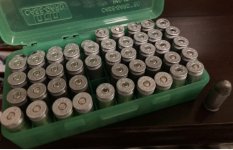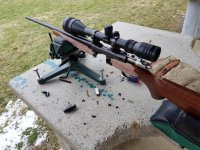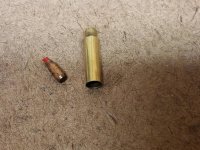cmj8591
Member
A while back I started a thread on my experiences loading 9mm aluminum cases.
There's no good reason to do this....but
Some of the people who responded to the thread questioned the endurance of the aluminum case. It got me thinking about how tough these cases are and how many times they could be loaded before they became unusable. I know, they are not supposed to be reloaded, there are plenty of brass cases, you'll vaporize your gun and shooting hand, yada, yada, yada. If you vehemently disagree with this little project and feel the need to tell the forum about it, feel free. But notwithstanding, it is a subject that interested me and I decided to explore it within my abilities. I started the original trial (for want of a better description) with 10, CCI, aluminum cases. I sectioned a couple to see how the insides were constructed and I lost a couple to the range gods. That left me with 6 cases. I used the same load, 4.4 grains of Bullseye with a 115 grain, plated bullet and a CCI standard primer and loaded them on my Dillon press just as if they were brass. All of the firings were done with a Glock model 45. It is very important to remember that the aluminum cases have about 10% less capacity than brass so you must reduce the load from the brass maximum to keep the pressure down. The pressure seemed fine with this load in this gun. I would have liked to have chronographed the load and compared it to brass cases just to get an idea of what is going on with the decreased volume but my chronograph gave up the ghost. Once I'm back online, I plan to revisit that aspect. Spoiler alert: I ended up loading the cases 9 times before they got to the point where it just didn't seem practical to continue. Before and after firing I measured the cases just forward of the web. After shooting they averaged .390. The sized diameter was .387. They stayed consistent but after 8 loadings, a ridge formed at .17 from the base of the case.
Here's a photo of the ridge.

I could feel the ridge and it reminded me of a belted magnum rifle case. I think what was happening at this point, is that the aluminum was starting to work harden and wasn't springing back after resizing. I also measured the case length after each firing. They started out at .742. By the third loading, they had grown to .746. They stayed at this length for the rest of the loadings. One of the signs of case head separation in a brass rifle case is the lengthening of the case. Brass from the base of the case flows forward and it thins out just forward of the head. Eventually it weakens enough that the case separates. I thought this was a possibility with the aluminum but it never happened. At the third loading, I did notice a ring forming at the inside of one of the cases at about the point where the base of the bullet would sit in a loaded case.
Photo of inside ring.

It was only in one case and I couldn't feel anything in the case wall. When I looked at some once fired cases at the range, I noticed the same ring in about ¼ of the ones I looked at. I'm not sure exactly what it is, but I'm thinking that it might have something to do with the coating on the aluminum being affected somehow at the base of the bullet when the powder burns. At any rate, it didn't seem to come into play. Everything was normal with the first 5 loadings. At load 6, one of the cases developed a .082 split down its side.
This is the crack after the 9th loading. Ugly!

I actually expected this to happen sooner because I was using a pretty healthy bell in the case mouth when I was loading. I loaded the case 3 more times. The split grew to .356" by the time I stopped and a second small split started on the opposite side at the 8th load. The case was still able to hold a bullet but was in pretty rough shape by the end. After the 9th and last loading, two other cases had developed splits. I did some research on the use of aluminum for cartridges and found quite a bit of information. A lot of it came off the action shooting blogs. They seemed to play around with loading aluminum more than anyone else. Of course the military has been using aluminum for years in things like the M1 Abrams round and the 30mm gun on the A10. I found an interesting study about attempting to use it for the 5.56 round. They tried a lot of different combinations of loads and coatings but in the end, nothing really worked out satisfactorily. Now they are testing bimetal cases and polymer cases. Who knows what they end up with but I wouldn't count out the brass case just yet. So what does this non scientific, anecdotal, small sample test prove? To me it confirmed a couple of preconceived notions. Aluminum is more susceptible to work hardening than brass. I don't know what the alloy that they use consists of, but I don't think the cases are just aluminum. If they were, I don't think I would have been able to get 9 loadings out of them without more failure. Up until the 5th loading, they held up as well as brass. It was the failure of the cases to spring back after sizing that ended the test. It also confirmed that aluminum cases are definitely reloadable more than once before they become compromised. It's a small test, 6 cases in one gun, but I think the results would be repeatable over a bigger sample with more platforms. I would like to try with about 100 cases and a couple of other shooters over several different guns. I also didn't use brass cases to compare the results to. As I said, this is a non scientific test. I can honestly say I don't really know how many loads a brass 9mm case is good for. I have enough brass 9mm for a life time and I can't remember having one fail. Of course I don't remember ever loading one more than a couple of time before it ended up on the ground or got buried back in the rotation. My suggestion to anyone thinking of reloading aluminum is if you feel the need, you can do it safely. Just remember the lesser capacity of the aluminum compared to the brass and reduce your load. Once the apocalypse supply chain issues ease and LabRadar's become available again, I plan to go back and see just what effect that reduced capacity has on this experiment. Maybe one of technophiles out there will beat me to it. I'm not sure what, if any, application loading aluminum has to the average shooter. About the only scenario that makes sense is if you shoot some of the action games or shoot in a place where you can't recover your spent cases and don't want to waste brass. Maybe the brain trust here has some ideas about why doing this could be practical. So the floor is now open.
There's no good reason to do this....but
Some of the people who responded to the thread questioned the endurance of the aluminum case. It got me thinking about how tough these cases are and how many times they could be loaded before they became unusable. I know, they are not supposed to be reloaded, there are plenty of brass cases, you'll vaporize your gun and shooting hand, yada, yada, yada. If you vehemently disagree with this little project and feel the need to tell the forum about it, feel free. But notwithstanding, it is a subject that interested me and I decided to explore it within my abilities. I started the original trial (for want of a better description) with 10, CCI, aluminum cases. I sectioned a couple to see how the insides were constructed and I lost a couple to the range gods. That left me with 6 cases. I used the same load, 4.4 grains of Bullseye with a 115 grain, plated bullet and a CCI standard primer and loaded them on my Dillon press just as if they were brass. All of the firings were done with a Glock model 45. It is very important to remember that the aluminum cases have about 10% less capacity than brass so you must reduce the load from the brass maximum to keep the pressure down. The pressure seemed fine with this load in this gun. I would have liked to have chronographed the load and compared it to brass cases just to get an idea of what is going on with the decreased volume but my chronograph gave up the ghost. Once I'm back online, I plan to revisit that aspect. Spoiler alert: I ended up loading the cases 9 times before they got to the point where it just didn't seem practical to continue. Before and after firing I measured the cases just forward of the web. After shooting they averaged .390. The sized diameter was .387. They stayed consistent but after 8 loadings, a ridge formed at .17 from the base of the case.
Here's a photo of the ridge.

I could feel the ridge and it reminded me of a belted magnum rifle case. I think what was happening at this point, is that the aluminum was starting to work harden and wasn't springing back after resizing. I also measured the case length after each firing. They started out at .742. By the third loading, they had grown to .746. They stayed at this length for the rest of the loadings. One of the signs of case head separation in a brass rifle case is the lengthening of the case. Brass from the base of the case flows forward and it thins out just forward of the head. Eventually it weakens enough that the case separates. I thought this was a possibility with the aluminum but it never happened. At the third loading, I did notice a ring forming at the inside of one of the cases at about the point where the base of the bullet would sit in a loaded case.
Photo of inside ring.

It was only in one case and I couldn't feel anything in the case wall. When I looked at some once fired cases at the range, I noticed the same ring in about ¼ of the ones I looked at. I'm not sure exactly what it is, but I'm thinking that it might have something to do with the coating on the aluminum being affected somehow at the base of the bullet when the powder burns. At any rate, it didn't seem to come into play. Everything was normal with the first 5 loadings. At load 6, one of the cases developed a .082 split down its side.
This is the crack after the 9th loading. Ugly!

I actually expected this to happen sooner because I was using a pretty healthy bell in the case mouth when I was loading. I loaded the case 3 more times. The split grew to .356" by the time I stopped and a second small split started on the opposite side at the 8th load. The case was still able to hold a bullet but was in pretty rough shape by the end. After the 9th and last loading, two other cases had developed splits. I did some research on the use of aluminum for cartridges and found quite a bit of information. A lot of it came off the action shooting blogs. They seemed to play around with loading aluminum more than anyone else. Of course the military has been using aluminum for years in things like the M1 Abrams round and the 30mm gun on the A10. I found an interesting study about attempting to use it for the 5.56 round. They tried a lot of different combinations of loads and coatings but in the end, nothing really worked out satisfactorily. Now they are testing bimetal cases and polymer cases. Who knows what they end up with but I wouldn't count out the brass case just yet. So what does this non scientific, anecdotal, small sample test prove? To me it confirmed a couple of preconceived notions. Aluminum is more susceptible to work hardening than brass. I don't know what the alloy that they use consists of, but I don't think the cases are just aluminum. If they were, I don't think I would have been able to get 9 loadings out of them without more failure. Up until the 5th loading, they held up as well as brass. It was the failure of the cases to spring back after sizing that ended the test. It also confirmed that aluminum cases are definitely reloadable more than once before they become compromised. It's a small test, 6 cases in one gun, but I think the results would be repeatable over a bigger sample with more platforms. I would like to try with about 100 cases and a couple of other shooters over several different guns. I also didn't use brass cases to compare the results to. As I said, this is a non scientific test. I can honestly say I don't really know how many loads a brass 9mm case is good for. I have enough brass 9mm for a life time and I can't remember having one fail. Of course I don't remember ever loading one more than a couple of time before it ended up on the ground or got buried back in the rotation. My suggestion to anyone thinking of reloading aluminum is if you feel the need, you can do it safely. Just remember the lesser capacity of the aluminum compared to the brass and reduce your load. Once the apocalypse supply chain issues ease and LabRadar's become available again, I plan to go back and see just what effect that reduced capacity has on this experiment. Maybe one of technophiles out there will beat me to it. I'm not sure what, if any, application loading aluminum has to the average shooter. About the only scenario that makes sense is if you shoot some of the action games or shoot in a place where you can't recover your spent cases and don't want to waste brass. Maybe the brain trust here has some ideas about why doing this could be practical. So the floor is now open.
Last edited:



